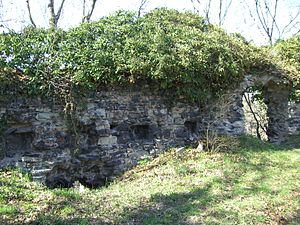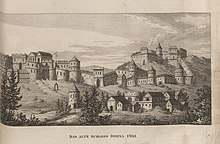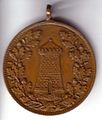Dohna Castle
| Dohna Castle | ||
|---|---|---|
|
Remnants of the wall of the old Dohna Castle |
||
| Alternative name (s): | Donin | |
| Creation time : | 10th century | |
| Castle type : | Höhenburg, spur location | |
| Conservation status: | Remnants of the wall | |
| Standing position : | Burgraves, nobility | |
| Place: | Dohna | |
| Geographical location | 50 ° 57 '10.7 " N , 13 ° 51' 16.2" E | |
| Height: | 155 m above sea level NN | |
|
|
||
The Dohna Castle , also called Donin , on the way to Bohemia was the ancestral seat of the Burgraves of Dohna . From the old, once stately double castle, only a small part of the wall remains. The remains of the old spur castle are located on the Schlossberg at 155 m above sea level. NN near the later development in the town of the same name in Dohna in the district of Saxon Switzerland-Eastern Ore Mountains in Saxony .
history
Defense system of the Sorbs
The area around the Schlossberg was already a settlement area for West Slav tribal groups in the early Middle Ages. The name of the associated settlement was Donin. The originally Slavic castle is said to have got its name from her.
It was from 1156 the center of the direct imperial castle counts of Dohna whose job it was an ancient trade route from Saxony to Bohemia to monitor the subject Sorbs in serfdom to keep and their Christianization advance by emissaries of the Catholic Church.
Dohna Castle until around the middle of the 12th century
The Dohna Castle was in connection with the dispute between King Heinrich III. (1039-1056) and Duke Břetislav of Bohemia in 1040 first mentioned in a document.
1085 married Wiprecht von Groitzsch , who later became Margrave of Meissen (1123-1124), Judith, the daughter of the Bohemian King Vratislav II (1061-1092). As a dowry, she brought the area in Gau Nisani and the area of today's Upper Lusatia around Bautzen into the marriage. In 1112 Wiprecht von Groitzsch lost the Gau Nisani with the Dohna Castle to Heinrich V (1106-1125). When Groitzsch regained ownership in 1117, Bohemian sovereignty was restored. In 1121 Vladislav I of Bohemia (1109–1125) rebuilt Dohna, which was probably destroyed around 1113.
In August Schumann Staatslexikon of Saxony (1814), a castle will recite mentioned: [...] and was, as then every stronghold, sometimes used as Staatsgefängniß according to the fashion. At least in the year of the Second Battle of Chlumec , the Bohemian Duke Soběslav I had some of the great Bohemians taken to the castle dungeon at Dohna [...].
Of the burgraves appointed as imperial officials, only one Erkembert from the Tegkwitz family (?) 1113 is mentioned, documented as Erkembertus prefektus de castro Donin . It is also known that the Erkenbertinger family (attested as burgraves in 1113) came from Franconia , gained a foothold near Naumburg and played a role in their younger Starkenberg line, among other things in the colonization of the Ore Mountains .
The eponymous ancestral seat of the von Donin family
As the progenitor of Donin, who ruled about 250 years down the dohna castle, Viscount applies Heinrich I. The investiture itself is not documented to be but has done no later than 1156, is when Henry first appropriate documentary mention as Burgrave of Dohna.
The strong Dohna Castle, on a rocky promontory 155 m above sea level. NN near the Müglitz , was the center of the manor and burgraviate Dohna . Here, who was Dohnaer Schoepp chair , one since 1390 attested Schöffengericht that to 1572 primarily in fief and successions to beyond the borders of Saxony had legal significance -.
It can be assumed that under the hereditary rule of the Burgraves of Donin, the castle was expanded into a stately double castle, consisting of a rear and front castle and a spacious forecourt. During the excavations of 1904/06 a transverse wall was found that separated the two castles.
The castle tower shown in the oval at the Fleischerbrunnen on the market square in Dohna, created in 1912 by the Dresden sculptor Alexander Höfer , corresponds to the tower in the oldest city coat of arms from 1525.
In his book Dohna, Stadt und Burg… (1843), Georg Friedrich Mörig compared two drawings of the old Dohna Castle, one from 1730 and the other from 1752. For the pen drawing from 1752, a mural on the Pfeifer estate in Gorknitz near Dohna served as a template. The estate burned down in 1760. Mörig wrote the following about the drawings:
- It is too regrettable that we cannot present a true picture of the former Dohna Castle. Heckel has attached a drawing in his Königsteiner Chronik, but it cannot be recognized as correct. A drawing attached here seems to us to border on truth, which, along with the aristocratic stamp, was painted in fresco on the Pfeiferschengut in Gorknitz , was preserved until the subsequent fire in 1760, but before that in 1752 by the appellate court Secretair Grundmann drawn with the pen on the public royal. Library to Dresden is located in Barzschen's Koenigsteiner Chronik.
Loss, decay and use of the Reichsburg
As a result of the Dohna feud (1385–1402) between Burgrave Jeschke von Dohna and the Saxon nobleman Hans von Körbitz (Korbs), the Burgraves lost the lordship with the entire land belonging to it to the Wettins . The current state border between Saxony and Bohemia was formed when the neighboring Pirna Castle with the associated villages and the Königstein Fortress , to which Burgrave Jesche had fled, came into the possession of the Wettins in 1406.
From the autumn of 1401 on, Dohna Castle was besieged and, after long resistance, was taken by storm on June 19, 1402 in the presence of Margrave Wilhelm I the One-Eyed (1349 / 79–1407), but not completely razed. The residential buildings were preserved and became the residence of the administrators of the Margravial Care Dohna. When the bailiffs moved their seat to Pirna from around 1457 , the gradual decline of the castle began. In the following times, the citizens of the city of Dohna also promoted the decay of the castle by transporting them away. On a picture from 1690 by A. Nienborg and on a drawing by Goebel from 1793, extensive remains of the wall and tower can be seen.
M. Christian Bartsch, pastor in Dohna, described the remains of the castle in 1735:
- […] On this castle mountain one can still find rudera of old walls, towers and vaults, which they have already stood in rain and weather for 330 years without regard to them; yet of lime and stones are so strong that they can hardly be torn, but cannot collapse by oneself. The Swedes, when they stood here in 1707 , tried and wanted to break into a vault on this castle hill, perhaps thinking they would find a treasure, but soon had to slack off because of the strength of the walls [...] .
At the moment only a small part of the wall of the Donin Castle can be seen. Apart from this remains of the castle, there is almost nothing left of the old Dohna Castle.
The development of the castle hill after the ruin of the castle fell into disrepair
In 1803 Heinrich Ludwig von Dohna bought the Schlossberg in order to rebuild the castle in the spirit of the emerging romanticism . For this purpose, the castle hill was cleared of rubble from the castle ruins and the construction of the round tower began. However, the Napoleonic Wars prevented the romantic plan from being carried out. Finally, the round tower was completed in its present form in 1830.
The "Privileged Rifle Society of Dohna" bought the Schlossberg in 1826 for 700 thalers and leveled the front part of the mountain. In 1828 she built the shooting house, the shooting wall and the retaining wall on the driveway from the stone material of the castle walls.
The present-day development on the Schlossberg consists essentially of the castle tavern, which was last used as an HO restaurant and dance hall, the former shooting house, and the round tower built in the style of the old castle, last used as a museum. Among other things, the local minerals of the Müglitz Valley, such as amethyst and agate , were shown here.
In the Burgschänke, formerly the HO restaurant "Burg Dohna", there has been a local history museum founded in 1906 on the upper floor since 1958. Today the museum is located in the former pharmacy property on the town's market square. Among other things, exhibits on the history of the castle such as finds from the Middle Ages, graphics and documents can be seen here.
Todays use
The buildings of the Schlossberg, the round tower from 1830 and the former castle tavern, have been expanded into a meeting place by the Christian free church Eckstein congregation since 2005. The sponsor is the registered association Horizonte Weltweit Eckstein .
The castle complex is protected as a ground monument, as is the Sorbs ski jump on the back of the mountain tongue of the Robisch (Robsch, Robscher). This castle complex can still be seen on a ledge above the station area. The reference to the complex is made because a Sorbian defense system also existed on the Robisch before the settlement of the castle hill (Schlossberg) .
The round tower from 1830 on the Schlossberg with a view of the Marienkirche
See also
- List of castles and palaces in Saxony
- List of ramparts in the Free State of Saxony
- Bracteates (Dohna)
literature
- Max Winkler and Hermann Raußendorf: The burgrave town of Dohna. In: Messages from the Saxon Homeland Security Association . Volume 25, items 1-4, Dresden 1936 ( data set of the German National Library ).
- Henning / Müller / Wintermann: Weesenstein. 700 years of castle history. Dresden 1995.
- Christine Klecker: How Dohna was lost. Weesenstein Castle Museum, 1991.
- Hans Eberhard Scholze: Weesenstein Castle. Leipzig 1969.
- Herbert Wotte: Baroque garden Großsedlitz / Dohna - Wesenstein - Wilisch , issue 99, VEB Bibliographisches Institut Leipzig, 1961.
- Author collective with Dr. sc. Werner Coblenz: Historical guide districts Dresden, Cottbus. Page 118: Dohna (with Dohna Castle). Urania-Verlag, Leipzig 1982.
- Karlheinz Blaschke: History of Saxony in the Middle Ages. Union Verlag Berlin 1990.
- Christian Bartsch: History of the old castle and Städgens Dohna. Dresden / Leipzig 1735 ( digitized ).
- Lothar Graf zu Dohna: Dohna. In: New German Biography (NDB). Volume 4, Duncker & Humblot, Berlin 1959, ISBN 3-428-00185-0 , pp. 43-46 ( digitized version ).
- Dohna . In: August Schumann : Complete State, Post and Newspaper Lexicon of Saxony. 1st volume. Schumann, Zwickau 1814, p. 756. Therein: Dohna Castle
- Eckhart Leisering: Acta sunt hec Dresdene - the first mention of Dresden in the document dated March 31, 1206 , Saxon State Archives, Mitteldeutscher Verlag (mdv), Halle / Saale and Dresden 2005, pages 96, ISBN 978-3-8981-2320-4 . Explanations about Dohna Castle, Dohna and Henricum burcgravium de Donin p. 5/11/20 / 25-34 / 33 / 49-50
Web links
- Internet presence of Horizonte Weltweit eV Eckstein
- Dohna Castle in Heimatfreunde Dohna ( Memento from May 5, 2012 in the Internet Archive )
- Website of the city of Dohna, including history - Dohna Castle
- Digital historical directory of Saxony - Dohna . In it: 1144 Heinricus praefektus , 1156 Heinricus castellanus de Donin .
- Digital historical directory of Saxony - Rötha . In it: 1127 Heinricus de Rotow, 1135 Rotwe, 1143 Rodewa, - 1127: manor house (around the middle of the 12th century change of location as burgrave to Dohna)
- East Prussia, information about the entire county of Dohna . In it: Henricus nobilis de Rotowe 1127/1156
- The von Dohna in the Wildenfels Castle Archives
- Reconstruction drawing by Wolfgang Braun
Individual evidence
- ↑ Annalista Saxo , ed. by Georg Waitz , in: MGH Scriptores (in folio) 6, Hannover 1844, pp. 542–777, here p. 684 line 41: Donin ( digitized version )
- ↑ Dohna . In: August Schumann : Complete State, Post and Newspaper Lexicon of Saxony. 1st volume. Schumann, Zwickau 1814, p. 755.
- ↑ Digital historical place directory of Saxony - Dohna (year 1113)
- ↑ Collective authors with Dr. sc. Werner Coblenz: Historical guide districts Dresden, Cottbus , page 118: Dohna (with Dohna castle). Urania-Verlag Leipzig – Jena – Berlin, Leipzig 1982
- ↑ From: Images of Dresden's old and new magnificent buildings, folk and court festivals. Copper notebook for the Chronicle of the Kgl. Saxon. Residenz-Stadt Dresden and the collector for history and antiquity, art and nature in the Elbthale. In the Ch. Fr. Grimmerschen Buchhandlung, Dresden 1835. SLUB Dresden Hist.Sax.G.0601.o http://digital.slub-dresden.de/id118749846 .
- ↑ Some historians put Heinrich I. von Dohna with Heinricus de Rodewa from a document of King Konrad III. for the Chemnitz Monastery of February 1143 the same; Heinrich is named as a witness. See the edition of the certificate at: The documents of Konrad III. and his son Heinrich , edited by Friedrich Hausmann (= MGH DD reg. et imp. Germ., Vol. 9), Vienna / Cologne / Graz 1969, no. 86, pp. 152–154, here p. 154, line 17 . For the first mention in 1143 cf. Karlheinz Blaschke, Dohna , in: Lexikon des Mittelalters, Vol. 3, Munich 1983, Sp. 1166.
- ↑ Furthermore, Heinrich I von Dohna is also referred to by some historians with Heinricus praefectus (without local addition!) From a document of King Conrad III. linked from November 1144, which settles a dispute between the Bishop and Margrave of Meissen ; Heinrich is named as a witness. In the name register of the MGH edition volume as Heinrich mentioned as early as 1143. Cf. The documents of Konrad III. and his son Heinrich , arr. v. Friedrich Hausmann (= MGH DD reg. Et imp. Germ., Vol. 9), Vienna / Cologne / Graz 1969, no. 119, pp. 212-214, here p. 214 line 4 ; on this in the name register p. 678 (left column) ; this thesis is also reflected in the HOV: Art. Dohna , in: Digitales Historisches Ortsverzeichnis von Sachsen , place name forms, entry on 1144, whereas the theses on 1127 and 1143 are not considered there.
- ↑ Heinricus castellanus de Donin in a document from Margrave Conrad I of Meißen from November 30, 1156; Heinrich is named as a witness. Cf. Codex diplomaticus Saxoniae regiae , IA 2: The documents of the Margraves of Meissen and Landgraves of Thuringia 1100–1195, ed. by Otto Posse , Leipzig 1889, No. 262, pp. 176-179, here p. 178, line 37 . Cf. Lothar Graf zu Dohna: Dohna. In: New German Biography (NDB). Volume 4, Duncker & Humblot, Berlin 1959, ISBN 3-428-00185-0 , pp. 43-46 ( digitized version )., P. 43.
- ^ Georg Friedrich Mörig: Dohna, town and castle from its origins to the most recent times. Dohna 1843, p. 132.
- ^ Karlheinz Blaschke: History of Saxony in the Middle Ages. Unionverlag Berlin, 1990.
- ↑ Christian Bartsch: History of the old castle and Städgens Dohna. Dresden / Leipzig 1735 digitized .










